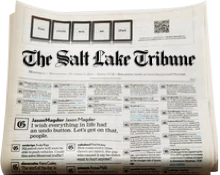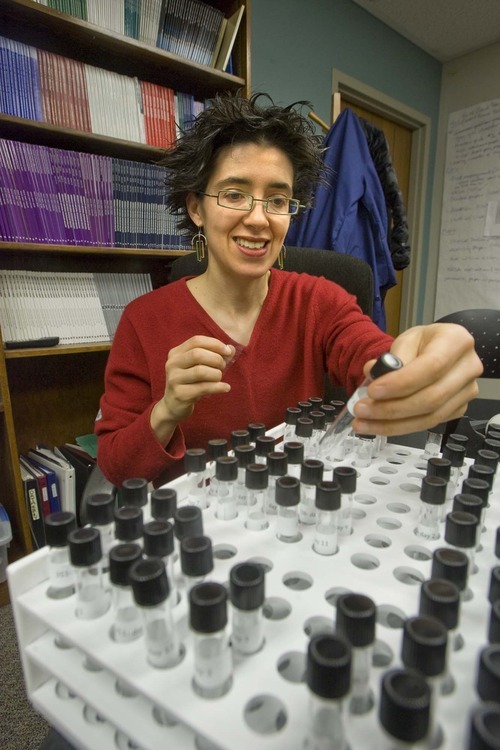This is an archived article that was published on sltrib.com in 2011, and information in the article may be outdated. It is provided only for personal research purposes and may not be reprinted.
Blue sparkly lights decorate the psychology professor's bookshelves and door frames. A container of cookies sits at the center of the room's table. The clink of test tubes fills the air as graduate students sort them into holding trays.
Holding court over it all is Lisa M. Diamond, associate professor of psychology and gender studies at the University of Utah. Diamond's voice changes neither its clipped tempo nor volume as she communes with students. Her voice, coming out of a thin woman, sounds as resolute and spiked as the appearance of the black hair coming out of her head like hundreds of exclamation points.
She hears that one of her best graduate students has become a father. "Get to work fostering a secure environment for attachment with your daughter!" she tells him over the phone, as if there's not a minute to waste.
Diamond, returning to her laptop computer with its leopard-skin screen saver, then enthuses over a student who finished her dissertation proposal. She praises another student whose article has been accepted for publication in a prestigious journal.
—
An academic volcano • "The Diamond Lab," as it's known among U. psychology students, is one of the hottest academic domains on campus.
"She's a volcano," said Kendrick Allen, a 27-year-old graduate student who's studied with Diamond for five years, three of them as an undergraduate student. "Her lab meetings are loud, almost raucous, events. It takes a certain amount of both respect and irreverence to study this subject."
"This subject" is Lisa Diamond's longtime exploration of human sexuality and all its heretofore-unmapped territory. It's perhaps the most volatile subject an academic could put her stamp on in an era when sex is still politicized, never mind sensationalized.
Diamond, 39, came to the U. in 1999. "Can a lesbian who studies sexuality really be happy in Utah?" she asked herself when contemplating the career move. "But I absolutely fell in love with Utah, and the university."
She soon became one of the most visible researchers in the field. A January 2009 New York Times Magazine article referred to her as a "newly prominent sexologist" and "tireless researcher."
Cynthia Berg, chair of the University of Utah's psychology department, calls Diamond one of the most creative and productive scholars she's ever seen.
Diamond's research focus on female sexuality is an example of that, according to Berg. She identified an un-met need, then crafted a research platform to tackle it. "Finding the right approach to a complex question doesn't stop her," Berg said. "She has all the requisite tenacity, and it's just infectious among her colleagues. We've recruited a lot of scholars to the department just because she's here."
—
Spit in this • Diamond recently turned her attention to studying the hormone levels in the saliva of 150 heterosexual couples over 14 days of samples to find links between biology and attraction.
"How are desires linked to hormone levels?" she asks, a cup of fizzing soda in hand. "Why is it that some women's attraction is more tightly linked to hormone levels, and others aren't? Maybe thousands of test tubes hold the answer."
Her previous research — a study of 100 women conducted over a period of more than 10 years — led to her groundbreaking 2008 book, Sexual Fluidity: Understanding Women's Love and Desire, published by Harvard University Press.
Diamond's study group included 40 lesbians, 30 bisexual women, plus 30 other women who considered their sexuality too nuanced for labeling. The research affirmed what many intuited but few had confirmed: Yes, sex and love are related in the minds of women, but not always in the ways we expect.
In fact, for some women, sex and love are unrelated to the point of near isolation. That idea became Diamond's professional passion. What she's interested in is how the answers help us better define and understand love and desire.
What's key for Diamond is the notion that understanding what women want is a journey of sorts, not necessarily a destination. If women's sexuality is in constant flux, how then can its "orientation" be detected? Links to estrogen and testosterone levels in saliva may hold the key, and her conclusions are seismic.
"Contrary to conventional wisdom, the majority of lesbian women experience sporadic attractions to men, just like the majority of heterosexual women experience sporadic attractions to women," she wrote in a recent e-mail about the preliminary findings of her most recent study.
Finding funding for these studies is tricky, she said. While the National Institutes of Health has funded some of her work on romantic relationships, her current estrogen/testosterone study is funded by the private American Institute of Bisexuality, while grants from the American Psychological Foundation funded some of her previous research.
—
Camera time — and then manipulation • Diamond was raised in Los Angeles and earned a doctorate in human development from Cornell University. Her initial research study was developed, in part, by her belief that all people must be accurately reflected in science.
As a lesbian, she was confounded that almost all research into homosexual desires centered on gay men. As a scientist and feminist, she was outraged that so many models for researching women's sexuality used outdated models. What was missing was a varied consideration of women's experiences with sex and desire.
For example, many studies were centered on teenagers' first sexual experiences, not when or why they felt their first sense of love, attraction or attachment.
"So many [researchers] were so interested in sex they never asked questions beyond that subject," Diamond said during an interview in her sixth-floor office overlooking the university's Rice-Eccles Stadium. "The deeper question of when, and even why, people feel their first sense of attraction was just as important, if not more so."
Diamond started research and interviews with her 100 subjects in 1995, before the dawn of e-mail. It was her first study, with no funding or resources except the 1989 Toyota Corolla she drove over the rolling hills of New York state to interview subjects. What emerged from her interviews over time was a portrait of women's sexuality that was fluid. Even among lesbian women, there was no one archetype of sexuality.
"The more I talked to them, the more I knew I was going to stick with the study," Diamond said. "It had me asking the most basic questions all over again: What is orientation? What is a propensity for desire? What counts as love? They're all confused, which makes for great research."
—
What do women want, anyway? • Diamond recalls the time in 2002 when she burrowed in her office, analyzing data, while across South Campus Drive, performers rehearsed for the Winter Olympics opening ceremonies in Rice-Eccles Stadium. When her book was finally published in 2008, it was heralded by academics and mainstream readers as a clarion call for acknowledging women's desires, almost a century after Freud posed his ubiquitous question: "What do women want?"
Oprah Winfrey became an instant fan. In March 2009, Diamond, her black tresses tamed downward by the show's crew, walked onto the television maven's Chicago stage to the strains of Jill Sobule's "I Kissed a Girl."
The show's producers were nervous before the show, Diamond recalls. Academic researchers normally have all the energy and charisma of a napping houseplant. Diamond proved every expectation wrong. "It was like an out-of-body experience," she says now.
The audience was rapt as she offered context about how women were more likely than men to fall into a broad range of authentic sexual feelings. It was normal for some women to take female partners, and then, sometimes, to switch back to male partners.
Diamond had Winfrey in the palm of her hand by show's end. "Thank you, Lisa Diamond, for writing this book!" the host said to exuberant applause.
At the other end of the spectrum was the National Association for Research and Therapy of Homosexuality, which in 2009 latched onto Diamond's research. Her conclusions about the fluidity of female desire were used to argue that homosexuality is a personal choice. Diamond was livid over what she characterized as "a willful misrepresentation of my findings."
"Experiencing one's sexuality as fluid and variable is not the same thing as choosing a lifestyle," she said. "The women I talked to had no control over changes to their sexuality over the years. They couldn't predict or control them."
—
The foundations of desire • For now, pronouncements about female sexuality aren't as important to Diamond as overhauling the processes and approaches by which female desire is investigated. It's the types of data considered that matter most, she says. She's still looking for people of both sexes of all orientations willing to volunteer their saliva.
"It is no longer sufficient to collect isolated snapshots of sexuality at a single moment in time," she writes in her book. "We must observe these changes as they occur."
What hasn't changed over her career is the very vehicle of her research, that rusted-white 1989 Corolla. She still pilots that same compact car that she drove around to interview her first subjects.
"My dad calls me up now and then, telling me to trade it in," Diamond says. "I will drive her until she absolutely falls apart on me, like that scene at the end of 'The Blues Brothers,' when John Belushi and Dan Ackroyd watch their beaten-up police cruiser collapse at the end of their journey."



